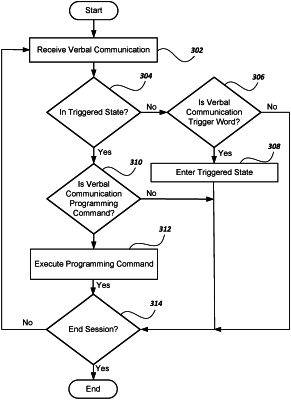| CPC G10L 15/22 (2013.01) [G10L 15/26 (2013.01); G10L 2015/223 (2013.01)] | 17 Claims |

|
1. A method for programming a stimulation device of a stimulation system using a programming device, the method comprising:
providing a predefined set of programming commands for the programming device, wherein the predefined set of programming commands comprises a first programming command increasing a stimulation amplitude and a second programming command comprises decreasing the stimulation amplitude;
receiving a verbal communication by a voice command handler of the programming device or in communication with the programming device;
determining whether the verbal communication is a trigger word and, when the verbal communication is the trigger word, entering a triggered state, wherein, after entering the triggered state, the programming device remains in the triggered state until a one of at least one stop condition is met; and
when in the triggered state, determining whether the verbal communication is one of the programming commands and, when the verbal communication is one of the programming commands, executing the one of the programming commands and then remaining in the triggered state for receiving another programming command,
wherein the at least one stop condition comprises at least one of: (1) not receiving verbal communication for a predefined time period of at least 10 seconds, or (2) receiving a predefined number of consecutive verbal communications that are not any of the programming commands.
|